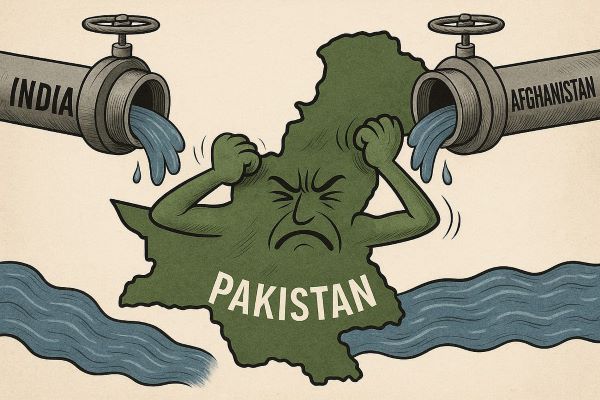 When Prime Minister Narendra Modi suspended the Indus Waters Treaty (IWT) in April, I wrote that it was a silent strike that could change Punjab’s destiny. (Operation Sindoor’s Silent Triumph: Modi’s Water Strike May Change Punjab’s Destiny) That decision was not a diplomatic formality; it was a strategic doctrine — a water bomb dropped without noise. Days later, I wrote that the message had gone home: “Khoon aur paani ek saath nahin beh sakte” — blood and water cannot flow together. (Khoon aur Paani: Modi’s Water Doctrine Has Pakistan on the Backfoot) India’s suspension of the treaty was not a reaction; it was a redrawing of the subcontinent’s hydrological balance. And now, that doctrine has found an echo — in Afghanistan.
When Prime Minister Narendra Modi suspended the Indus Waters Treaty (IWT) in April, I wrote that it was a silent strike that could change Punjab’s destiny. (Operation Sindoor’s Silent Triumph: Modi’s Water Strike May Change Punjab’s Destiny) That decision was not a diplomatic formality; it was a strategic doctrine — a water bomb dropped without noise. Days later, I wrote that the message had gone home: “Khoon aur paani ek saath nahin beh sakte” — blood and water cannot flow together. (Khoon aur Paani: Modi’s Water Doctrine Has Pakistan on the Backfoot) India’s suspension of the treaty was not a reaction; it was a redrawing of the subcontinent’s hydrological balance. And now, that doctrine has found an echo — in Afghanistan.
Days after India’s bold move, Afghanistan announced plans to build dams on the Kunar River, which flows into Pakistan’s Khyber Pakhtunkhwa province. Taliban Supreme Leader Mawlawi Hibatullah Akhundzada has ordered construction “as fast as possible.” For Pakistan, this is a nightmare unfolding in real time. The Kunar feeds the Kabul, which in turn joins the Indus — Pakistan’s lifeline. If the Taliban proceeds, Pakistan will be choked from both sides — India in the east, Afghanistan in the west.
The reaction from Rawalpindi has been as predictable as it is desperate. After India suspended the treaty, Pakistan’s Army Chief General Asim Munir threatened to “destroy any infrastructure India builds on the Indus water channels.” According to NDTV’s report, Munir even boasted that Pakistan had “no shortage of missiles” and warned that if India dammed the rivers, they would “take half the world down with us.” Such nuclear bluster exposes Pakistan’s growing panic. When a nation’s most senior military officer threatens Armageddon over river management, it signals strategic bankruptcy.
And now, with Afghanistan asserting its right to build on the Kunar, will Pakistan issue the same threat to the Taliban? Will Asim Munir dare to warn Kabul of “ten missiles”? Unlikely — because this time, Pakistan’s old playbook doesn’t work. The Taliban no longer takes dictation from Islamabad.
For decades, Pakistan exported terror while importing water. It accused India of “weaponizing rivers” even as it bled Punjab’s aquifers dry through the Indus Waters Treaty’s one-sided design. Now, both its upstream neighbours have had enough. From the east, India has asserted its rights over the Indus, Jhelum and Chenab. From the west, Afghanistan is reclaiming control over the Kunar and Kabul. Two sovereign states, acting independently, have turned Pakistan’s water arrogance into isolation.

Is former Member of Punjab Public Service Commission
A farmer and keen observer of current affairs
Pakistan’s biggest vulnerability is not military — it’s hydrological. Over 75 percent of its freshwater originates outside its borders. The Indus, Jhelum, Chenab, Kunar and Kabul — none rise in Pakistan. For a nation that made the Indus its identity, this is its ultimate dependence. When both upstream taps tighten, the canals of Sindh and Multan will dry before the rhetoric does.
For India — and especially Indian Punjab — this regional shift is more than geopolitical theatre; it is a moment of reckoning. The Indus Waters Treaty crippled Indian Punjab’s natural right over its own rivers, diverting their bounty to Pakistan’s Punjab and leaving the land of five rivers to depend on dying aquifers. For decades, Indian Punjab paid the ecological price of political appeasement. Now, with the treaty in suspension, India has a rare chance to reclaim riparian justice — to restore balance between what geography granted and history denied. This is not merely about water; it is about equity, ecology, and the survival of Punjab’s future generations.
Even the Centre appears to recognize this. According to NDTV’s recent report, New Delhi is finalizing plans for a massive “Indus gift” for North India ahead of the 2029 elections — a network of tunnels and canals designed to harness Indus waters that earlier flowed into Pakistan, potentially redirecting them toward Punjab, Haryana, and Rajasthan. If implemented wisely, this could mark the first real hydrological restitution for Indian Punjab since Partition.
No army marches, no missiles fly — yet the strategic order of South Asia is shifting drop by drop. In this new era, water is both weapon and warning. As I wrote before: “When you beat your enemy with silence, it echoes louder than war.” That echo now rolls down the Himalayas — from Srinagar to Kunar — and Pakistan hears it from both sides.
Overall, a larger danger looms over the geopolitics of this region. Pakistan remains a perpetual threat to India, continuing its “thousand cuts” doctrine even as it collapses from within. Its economy is in shambles, its internal instability rising, and now its conflict with Afghanistan escalating. A nuclear-armed state with shrinking rivers, broken governance, and growing desperation is a recipe for regional volatility. This is why India’s and Afghanistan’s quiet assertion over water isn’t just a matter of rights — it’s a matter of regional survival. The age of water wars has begun, and it will demand nerves of steel and depth of vision — not noise.